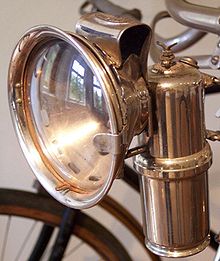| Revision as of 16:32, 2 September 2006 editCoga2006 (talk | contribs)17 editsNo edit summary← Previous edit | Revision as of 16:34, 2 September 2006 edit undoBeetstra (talk | contribs)Edit filter managers, Administrators172,049 edits RV to 70413018 (2006-08-18 12:54:54) by Atlant using Popups - spam linkNext edit → | ||
| Line 23: | Line 23: | ||
| ==External links== | ==External links== | ||
| * | * | ||
| * | |||
| ==See also== | ==See also== | ||
| *] | *] | ||
Revision as of 16:34, 2 September 2006

Carbide lamps (acetylene lamps) are simple lamps that produce and burn acetylene gas produced by reacting calcium carbide with water.
These lamps were formerly found in mines (not to be confused with the Davy lamp), vintage cars, and lighthouses; they are still sometimes used by cavers and cataphiles.
Pellets or chunks of calcium carbide (CaC2) are placed in the lower chamber (the generator). The upper chamber is then filled with water. A screw valve or other mechanism is used to control the rate at which the water is allowed to drip into the chamber containing the calcium carbide. By controlling the rate of water flow, the production of acetylene gas is controlled. This, in turn, controls the size of the flame (and thus the amount of light it produces).
The carbide lamp generally has a reflector behind the flame to redirect light in a more useful direction. A carbide lamp produces a surprisingly bright, broad light. Many cavers prefer this type of unfocused light as it improves peripheral vision in the completely dark environment.
The reaction of calcium carbide with water produces a fair amount of heat independent of the flame. In cold cave environments, carbide lamp users can use this heat to help stave off hypothermia.
When all of the carbide in a lamp has been reacted, the carbide chamber contains a wet paste of caustic lime (Calcium hydroxide). This is emptied into a waste bag and the chamber can be refilled. The residue is toxic to animals and should not be deposited in locations where animals may consume it. However, over time the hydroxide will react with atmospheric Carbon dioxide to form Calcium carbonate, which is non-toxic.
In cave survey, carbide lamps are favored for the lead or "point" surveyor, who must identify suitable points in the cave to designate as survey stations. The sooty carbide flame may be used to harmlessly mark cave walls with a non-toxic and removable station label. Especially favored for this purposes are all-brass lamps or lamps made with no ferromagnetic metals, as these lamps do not deflect the needles of the magnetic compass, which is typically read while brightly illuminated from above using the caver's lamp. If a permanent magnet is not attracted to a lamp part, then that part is suitable for use in cave survey (the body of the lamp may be brass, but the reflector made of ordinary steel, so both must be checked. Austenitic stainless steel reflectors are suitable.)
Apart from their use as cave surveying tools, many cavers favor carbide lamps for their durability and quality of illumination. They were once favored for their relative illumination per mass of fuel (carbide versus batteries), but this advantage is less significant or reversed with the advent of high-intensity LED illumination. The acetylene-producing reaction is exothermic, which means that the lamp's reactor vessel will become quite warm to the touch: this can be used to warm the hands. The heat from the flame can also be used to warm the body by allowing the exhaust gasses to flow under a shirt pulled out from the body: such a configuration is referred to as a "Palmer furnace" for SUNY Oneonta geologist Arthur N. Palmer.
Small carbide lamps called "Carbide Candles" are used for blackening rifle sights to reduce glare. These "candles" are used due to the sooty flame produced by acetylene.
The design of the lamp was first patented in Duluth, Minnesota on October 21, 1902 (U.S. patent 711,871).
External links
See also
| Lighting | |||||||||||||
|---|---|---|---|---|---|---|---|---|---|---|---|---|---|
| Concepts | |||||||||||||
| Methods of generation |
| ||||||||||||
| Stationary | |||||||||||||
| Portable | |||||||||||||
| Automotive | |||||||||||||
| |||||||||||||
| |||||||||||||
| |||||||||||||
| Related topics | |||||||||||||
This technology-related article is a stub. You can help Misplaced Pages by expanding it. |